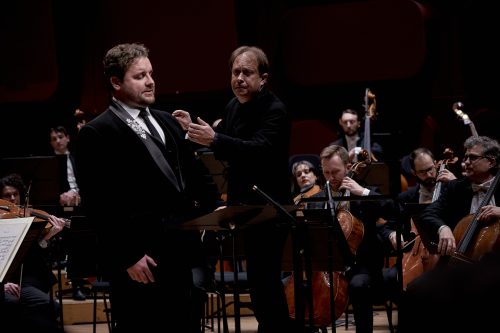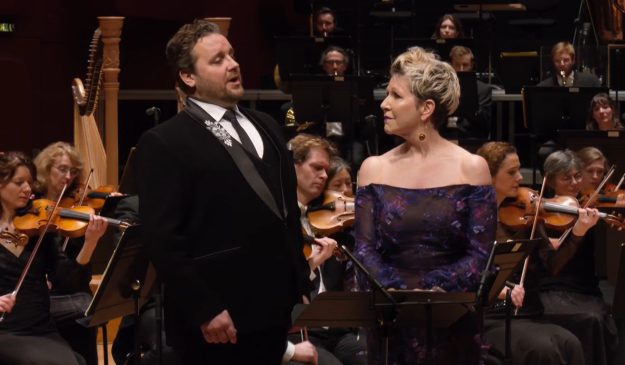 France Berlioz and Wagner: Joyce DiDonato (mezzo-soprano), Michael Spyres (baritenor), Orchestre Philharmonique de Strasbourg / John Nelson and Ludovic Morlot (conductors). Livestreamed on medici.tv (directed by Jean-Pierre Loisill) from the Palais de la Musique et des Congrès, Strasbourg, France, 26.1.2024. (JPr)
France Berlioz and Wagner: Joyce DiDonato (mezzo-soprano), Michael Spyres (baritenor), Orchestre Philharmonique de Strasbourg / John Nelson and Ludovic Morlot (conductors). Livestreamed on medici.tv (directed by Jean-Pierre Loisill) from the Palais de la Musique et des Congrès, Strasbourg, France, 26.1.2024. (JPr)

Berlioz – Chasse royale et orage; ‘Nuit d’ivresse et d’extase’ (Les Troyens, Act IV); Cleopatra scène lyrique; Roméo seul, tristesse, bruits de concert et de bal; Grande fête chez Capulet (Roméo et Juliette, Op.17, Part II)
Wagner – Wesendonck-Lieder, WWV 91
I am sure I am wrong to consider Hector Berlioz a three-hit wonder as I have only really encountered his 1830 (apparently) opium-inspired ‘program music’ Symphonie fantastique, his 1845 part-oratorio, part-opera La damnation de Faust and an 1858 opera Les Troyens. (Though this is possibly down to my musical ignorance than anything else.) In a concert partly recreating a recent Erato release with some of the same musical forces (the Strasbourg Philharmonic Orchestra, the – now rather frail – American conductor John Nelson and mezzo-soprano Joyce DiDonato) I heard in concert more Berlioz than I have ever done.
It was a rather oddly programmed concert and – though there are a number of reasons why I am not in the concert hall more often – I wonder why people will buy tickets for an evening where the music actually played was significantly less than ninety minutes! It began with Berlioz’s Chasse royale et orage (Royal Hunt and Storm) from Les Troyens conducted by French conductor Ludovic Morlot. Despite the horn calls the hunt begins quietly with the first of many important contributions from oboist Samuel Retaillaud and the music excitingly ramps up as the storm approaches (intriguingly similar to Rossini’s 1829 William Tell Overture). The timpani and brass become more prominent and since we know about Berlioz’s influence on Wagner here there is ‘a chicken and egg situation’ because there are hints of the Ride of the Valkyries, but it is not entirely clear what came first. Finally, the sound of the music ebbs away with more from Retaillaud’s oboe, as well as Sandrine François’s flute.
More ignorance on my part but when I first saw the concert advertised I expected Joyce DiDonato to sing the Wesendonck-Lieder when actually it was to be baritenor Michael Spyres and the first time I have heard a male singer perform them all …and, in the end, not something I would wish to hear again. Wagner’s perfect-in-miniature masterpieces were composed in the late 1850s when he was ‘involved’ with Mathilde Wesendonck in what may have just been an affair of the mind, though it did inspire the five poems of hers he set to music and which led to the creation of Tristan und Isolde with music from the third act and second act heard in the songs, Im Treibhaus and Träume, respectively. (The songs were originally written for piano accompaniment but were later orchestrated by Wagner’s friend Felix Mottl.)

Spyres’s singing was undermined for me by the focus of his eyes being on the iPad in front of him and not the audience. The initial two songs came and went with the angel of the first one remaining earthbound and thoughts of nature in the second (Stehe Still!) having little radiance or transcendence. I began to wonder whether Spyres has studied Tristan because Im Treibhaus was notably better, and he floated ‘Luft’ and ‘Duft’ and caressed the musical line more. What was never in doubt over the five songs was Spyres’s exemplary delivery of the texts and the sensitive accompaniment he received from Morlot and his virtuosic musicians. Sadly, Schmerzen was an example of – what I describe as – can belto; though the final song again suited his voice however the repeated word ‘Träume’ needed to be, well, dreamier.
The descent of Spyres’s very last Wesendonck words ‘sinken in die Gruft’ gave evidence of the impressive artistry he has at his command given the right repertoire and this was confirmed after the interval in the love duet ‘Nuit d’ivresse’ (‘Drunken night’) again from Les Troyens. Spyres was joined by Joyce DiDonato and the orchestra was now conducted by a batonless – and mainly seated – John Nelson who conjured up some finely-shaded orchestral support. Now it was a case of Spyres who knew the score and DiDonato who needed it. Spyres was ardent and lyrically expressive and somewhat outshone DiDonato though it all sounded suitably sensuous. Their voices blended superbly in this deeply intimate and romantic duet set to music which I believe foreshadows Didon’s tragic end when Enée abandons her.
A 25-year-old Berlioz submitted ‘La Mort de Cléopâtre’ for the Paris Conservatory’s prestigious Prix de Rome in 1829 and was unsuccessful for a third time. There is apparently an anecdote about how a professor would have preferred ‘soothing music’ with Berlioz retorting how it was not easy to write anything soothing about an Egyptian queen dying an agonising death after being bitten by a poisonous snake! Passages soar and then stagnate and – to be truthful – I wondered if it would ever end.
DiDonato usually has a consummate ability to communicate what she is singing about to an audience, though again this was hampered her by her looking at the music. Nevertheless, she successfully revealed a regal and wounded Cleopatra resigned to her impending fate and was I the only one to think they actually felt the bite of the snake? Was that DiDonato’s artistry or more probably Berlioz’s especially when he has composed it so effectively – and affectingly – in his music and then with its stuttering strings we experience the queen’s faltering heartbeat as she dies. Of course, you would expect DiDonato’s dramatic, dark-sounding mezzo-soprano tones to fit this work perfectly, which they do, however the upper reaches of her voice do not have the ease of earlier years and faster passages were occasionally somewhat of a challenge.
In the final two extracts from Berlioz’s choral symphony homage to Shakespeare’s Romeo and Juliet Nelson and the Strasbourg Philharmonic Orchestra revelled in the composer’s musical kaleidoscope and together they proved almost to be a tone poem on their own. A sad Romeo is depicted alone (more excellence here from the oboe of Retaillaud) and as Leonard Bernstein once demonstrated the ‘love-sick sighs’ found their way into Tristan und Isolde, so why didn’t the orchestra have the Prelude to Act I in the programme? Then we heard a more rumbustious ‘Distant sounds from the concert and the ball’ and a certain triumphalism in the ‘Great banquet at the Capulets’ before Nelson and his excellent orchestra brought the concert to a rousing conclusion.
Jim Pritchard
Featured image: Michael Spyres and Joyce DiDonato sing Berlioz’s ‘Nuit d’ivresse’
